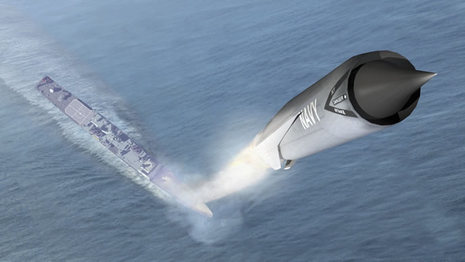Lockheed Martin Receives Contracts Worth $218 Million for Demonstration of Second Round in Future US LRASM Anti-Ship Missile Programme
no-reply@blogger on Wednesday, February 16, 2011
Despite the currently improving ties between the US and China, it can be expected that China will be the determining factor in US military development during the foreseeable future.
As those military operations, which urged western Armed Forces to refocus on so-called asymmetric warfare, are being considered more or less under control and probably achievable in a rather predictable time frame, other potential conflict areas that had been neglected during the past decade begin to slide back to the centre of attention. As if awakening from a nightmare of dirty wars in dusty countries, recently increased tensions on the Korean Peninsula and China’s military build-up have urged the US military leadership and defence analysts to rediscover the necessities of conventional warfare in order to sustain the United States’ superpower status in the future.*
China is very much helping to cement this reasoning: The J-20 fifth-generation fighter aircraft made its maiden flight while US Defense Secretary Gates was in the country, and reports of China’s tangible efforts to build an aircraft carrier emerged just as Chinese President Hu Jintao prepared to meet Barack Obama in Washington ... coincidences? Further, reports of an ominous Chinese anti-ship missile, capable of sinking US aircraft carriers, spooked through the media during the past months.
In this context, the US Navy in 2009 asked the Defense Advanced Research Project Agency (DARPA) to support its effort to speedily develop a next-generation stand-off anti-ship weapons system. As current systems, such as the Harpoon RGM-84, are ageing and may not meet future requirements in terms of range, lethality and resistance against defensive measures, the US Navy and DARPA established the Long-Range Anti-Ship Missile (LRASM) programme. Within the framework of this programme, two different missile solutions will be developed and have to demonstrate their worth to be quickly introduced into service with the US Navy’s vessels.
PHASE 2 – DEMONSTRATION OF BOTH MISSILE VARIANTS
Having successfully completed Phase 1, which resulted in two preliminary system designs that will be further explored, DARPA has recently awarded contracts to Lockheed Martin for the programme’s next phase. As Lockheed Martin announced yesterday, it received two contracts worth $218 million for the demonstration of the LRASM-A and LRASM-B concepts. The second phase of the programme aims at achieving successful flight demonstrations of tactically relevant prototypes of both missiles.
Lockheed Martin’s Missiles and Fire Control Strike Weapons division received a $60.3 million contract for two air-launched demonstrations of the LRASM-A, which is largely based on the company’s experience with the Joint Air to Surface Standoff Missile Extended Range (JASSM-ER) airframe. Further, under a $157.7 million contract, the Missile and Fire Control Tactical Missiles division will demonstrate the LRASM-B prototype, comprising four Vertical Launch System (VLS) launches. According to DARPA, the LRASM-B leverages Lockheed Martin’s prior ramjet development activities and a suite of supporting sensors and avionics. It is expected to provide a “supersonic cruise missile with balanced speed and stealth for robust performance.”
Despite being matched with the VLS, used on the US Navy’s destroyers and cruisers to launch state-of-the-art surface-to-air and surface-to-surface missiles (SAM/SSM), both missile solutions are also designed to be launched by aircraft. Thus, it will replace the air-launched Harpoon variant (AGM-84), which is deployed by various fixed-wing aircraft in the US inventory.
BAE Systems will provide a common sensor system for all missile variants. In addition to multiple sensors, allowing the missile to autonomously select targets even in a cluttered sea lane and in a GPS-denied environment, AviationWeek predicts that the core of the sensor suite will be based on passive radio-frequency technology.
Rick Edwards, vice president of Tactical Missiles and Combat Maneuver Systems at Lockheed Martin Missiles and Fire Control, explained: “Both of our LRASM solutions will deliver extraordinary range, willful penetration of ship self-defense systems and precise lethality in denied combat environments.”
“The maturity of these weapons and technologies allows near-term transition to Navy magazines at an affordable price. These are low risk, practical options with the Navy initiating studies of anti-surface warfare capability,” Edwards continued.
A CHALLENGING UNDERTAKING – TIME, CAPABILITIES, TECHNOLOGY
As its current anti-ship capabilities are limited in the face of today’s potential conventional threats, the Navy is anxious to introduce its next-generation anti-ship missile system as soon as possible. As yet, this is expected to be achieved as early as 2013. However, many challenges remain before a truly operational system will be available.
The Navy made high demands with regard to the systems’ capabilities. Currently deployed systems require a considerable amount of planning, as well as reliable data and precision guidance, to successfully strike their targets. Thus, the Navy needs a solution that allows its vessels to engage targets well outside their striking range while also providing a significantly increased flexibility and independence.
When the programme was initiated in 2009, Rob McHenry, programme manager in DARPA’s Tactical Technology Office, summarised the requirements as follows: “Once the missile flies that far, it has a requirement to be able to independently detect and validate the target that it was shot at. Once it finds that target, then it has to be able to penetrate the air defenses. The standard of maritime integrated air defenses has risen dramatically over the past few years.”
----
By Nicolas von Kospoth, Managing Editor
View the original article here

0 comments:
Post a Comment